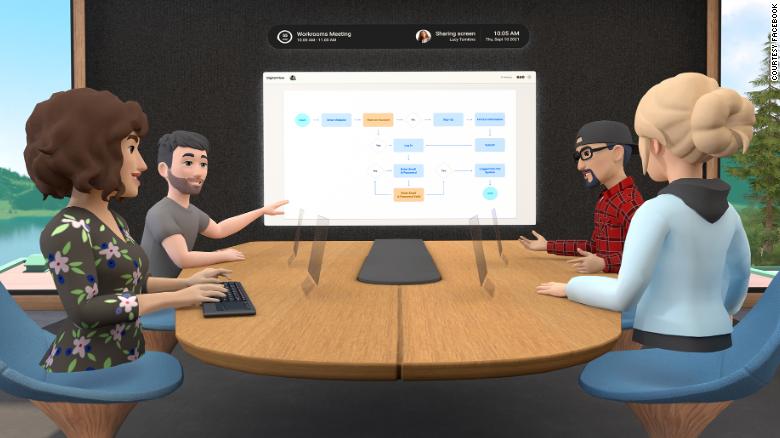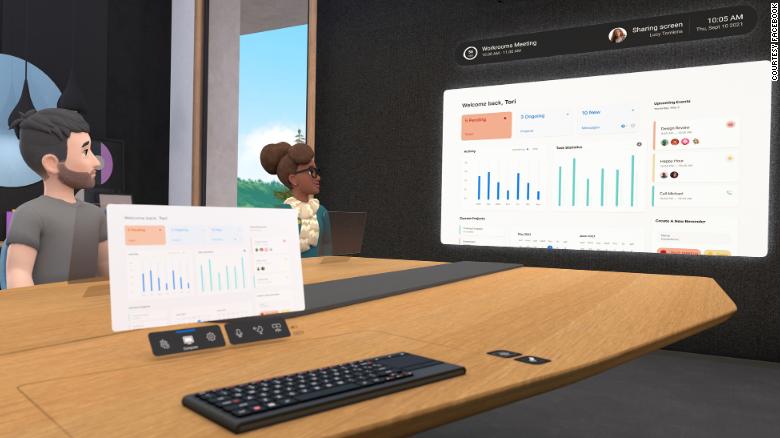Facebook wants you to hold your next meeting in VR

Facebook wants you to hold your next meeting in VR
For those who think zoom meetings are not enough to replace real meetings, Facebook has another idea, a virtual reality / VR application that makes you and your colleagues feel like you’re sitting at a table in a conference room.
On Thursday, Facebook launched horizon workroom, a free app for Oculus Quest 2 headset users, starting at $299. The application is the company’s most ambitious effort to date. Aimed at enabling groups to socialize in virtual reality and diverting this still niche media from entertainment uses such as games.
Facebook wants you to hold your next meeting in VR
The workroom allows up to 16 VR headset users to meet in the virtual conference room. Everyone can be represented by a customizable cartoon image, which looks like an Upper-body floating above the virtual chair on the table. The application supports up to 50 participants in a meeting. The other participants can join as video callers, who appear on the grid-like plane screen of the virtual conference room.
Conference participants wearing headphones can use their fingers and hands to make gestures in virtual reality. And their avatar’s mouth moves in a realistic way when talking. Virtual whiteboards allow people to share pictures or make presentations.
Andrew Bosworth, vice president of Facebook reality labs, said in a (virtual) room of about 12 people on Tuesday. “the pandemic in the past 18 months has only made us more convinced of the importance of this technology.”. He has mentioned that Facebook has been using the application internally for about a year.

This is not the first time Facebook and its subsidiary Oculus have tried to promote social interaction through virtual reality. The company launched the virtual social applications oculus rooms and Facebook spaces in 2016 and 2017 respectively, allowing a small group of users to gather in virtual reality. However, the company closed these two VR applications in October 2019. Instead, it announced a virtual social world called horizon, which will be released in 2020. Horizon has not yet been released to most users. Facebook confirmed this week that the app is still in the private beta testing stage.
The workroom can provide users with a sense of the future. This shows how much progress Facebook has made in the integration of hardware and software and how far it still has to go since the acquisition of oculus in 2014.
It’s a step forward – but it’s not the metaverse yet
In recent weeks, Facebook CEO Mark Zuckerberg and other technology industry executives have expressed growing enthusiasm for the vision of metaverse. The word is inspired by a dystopian science fiction thought decades ago. That is a virtual world that can escape the reality of daily life. Although the origin is bleak, technology executives are optimistic about what such a metaverse may be. Facebook even created a “metaverse product group” under the leadership of Bosworth.
The workroom looks like a step towards a more social virtual world, but it’s not like what Zuckerberg described.
The application uses a series of technologies and techniques to make your experience as real as possible when you express yourself in the form of animation in the virtual space.
People wearing headphones can view their real computer screen in virtual reality through the included desktop application. In addition, the workroom also combines manual tracking and spatial audio (which can explain the acoustic effect of the room and make the sound appears to come from a specific direction), allowing users to interact in a way that simulates real life, except for the sound cancellation function to eliminate background noise.

It is obvious that Facebook is still solving some problems. Facebook executive Bosworth is describing how he sees the studio as a more interactive way to have real communication with his colleagues rather than video chat. His avatar freezes the middle sentence, and the pixels of his digital skin change from flesh tone to gray. He was disconnected.
Oculus Quest 2 headset
Even with the launch of the workroom, Facebook still faces some problems perplexing virtual reality. It must persuade people (or the company) to buy headphones, use them regularly, and adapt to new ways of interaction. Whether with the virtual world or with others in the virtual world – which are far from perfect.
For example, although Quest 2 can track hands, even a single finger, which allows users to make natural gestures during the conversation. Or Flash OK signs in virtual reality when using the workroom. If you try to touch both hands at the same time in a virtual reality conference, it is likely that they just overlap in an embarrassing way, breaking the illusion of reality and existence.
Then the headset itself. Bosworth said he expects users to use the application for about 30 minutes at a time, and another Facebook team is working to improve the ergonomics and weight of virtual reality headphones. Quest 2 currently weighs a little more than a pound. It may not sound too heavy, but it is definitely eye-catching during the half-hour meeting.
(Facebook stopped selling the headset at the end of July. following a voluntary recall related to reports that the removable foam face pad of the headset causes skin irritations. The company said it would resume sales of the headset on August 24, this time with a silicone pad cover.)
However, Bosworth points out that one thing the application can’t improve is how attractive the meeting is.
“Even virtual reality can’t make your boring meetings less boring,” he said.
We would like to hear about your problems, questions, and suggestions. So feel free to contact us.
Lucas Noah, a distinguished writer with a Bachelor of Information Technology (BIT) degree, is currently making waves in the digital content sphere with his contributions to Creative Outrank LLC and Oceana Express LLC. His work on their websites showcases hi... Read more